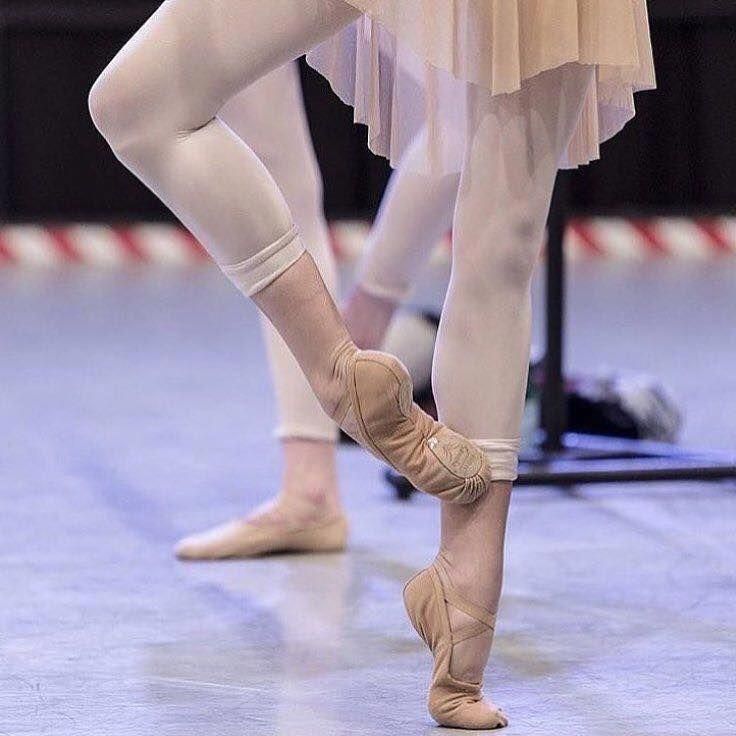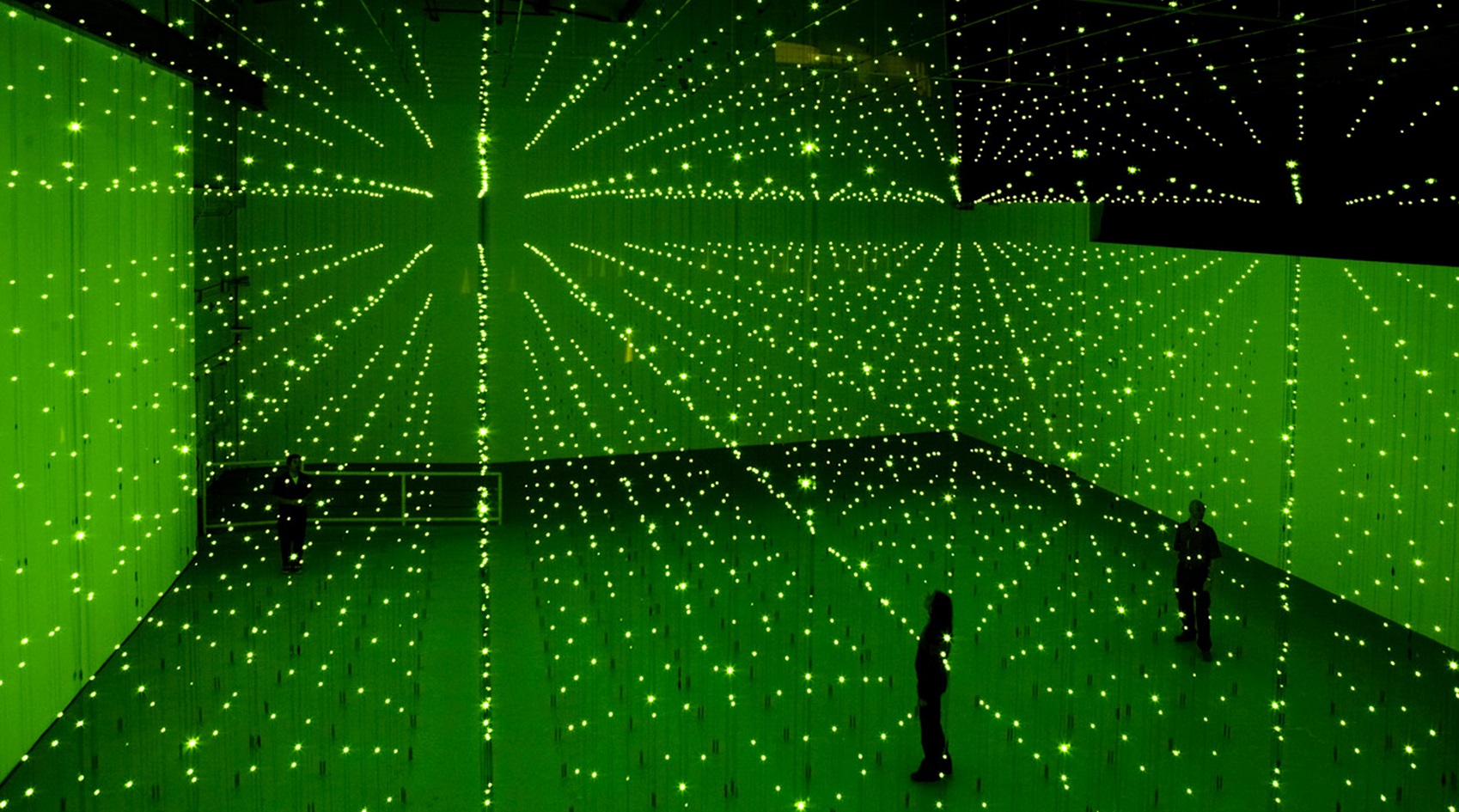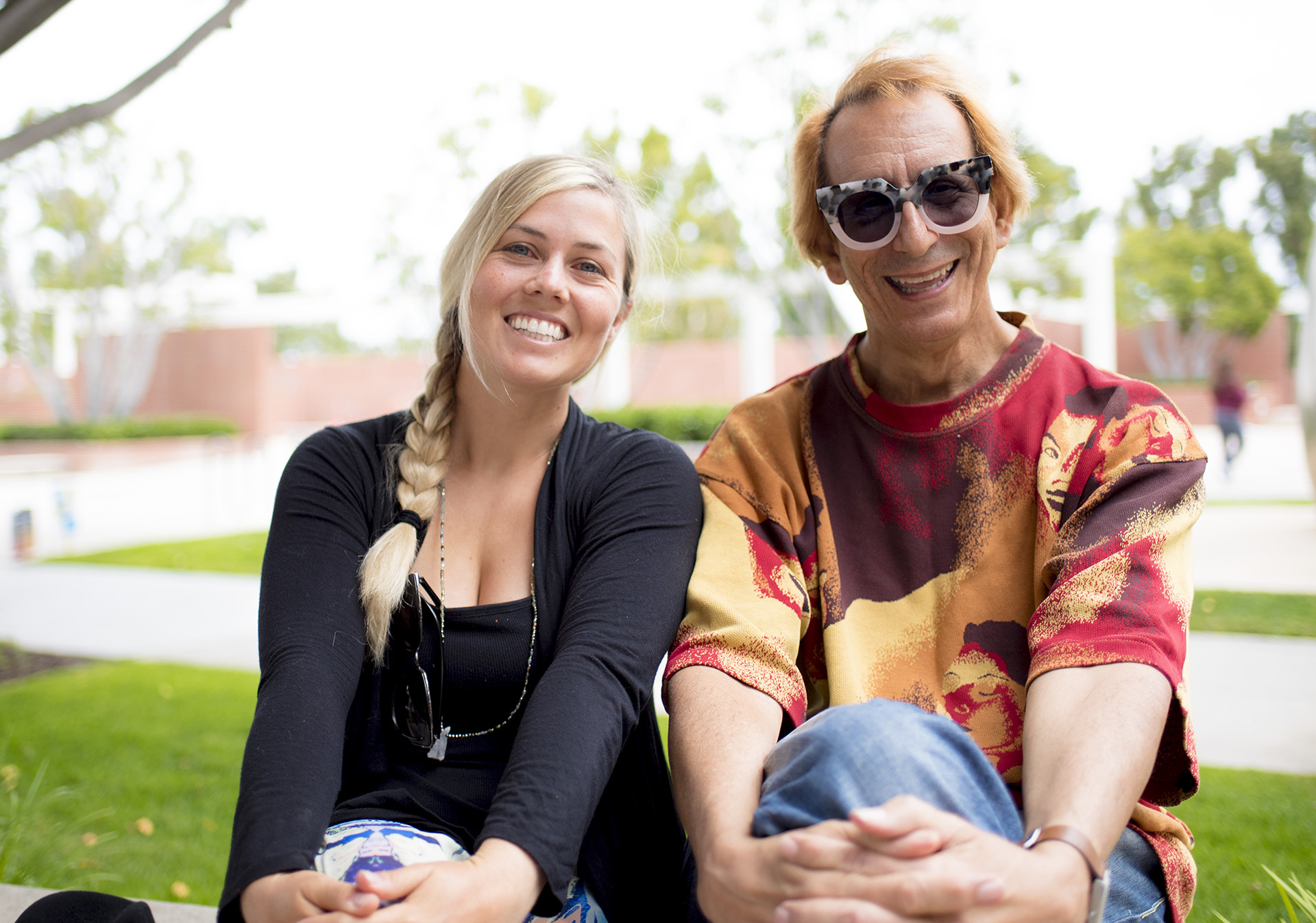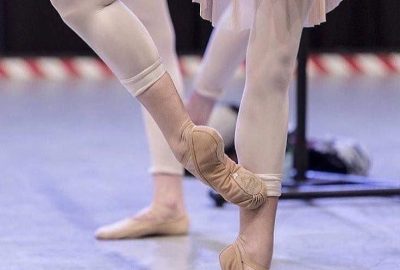Ballet Dictionary
Ballet Terminology
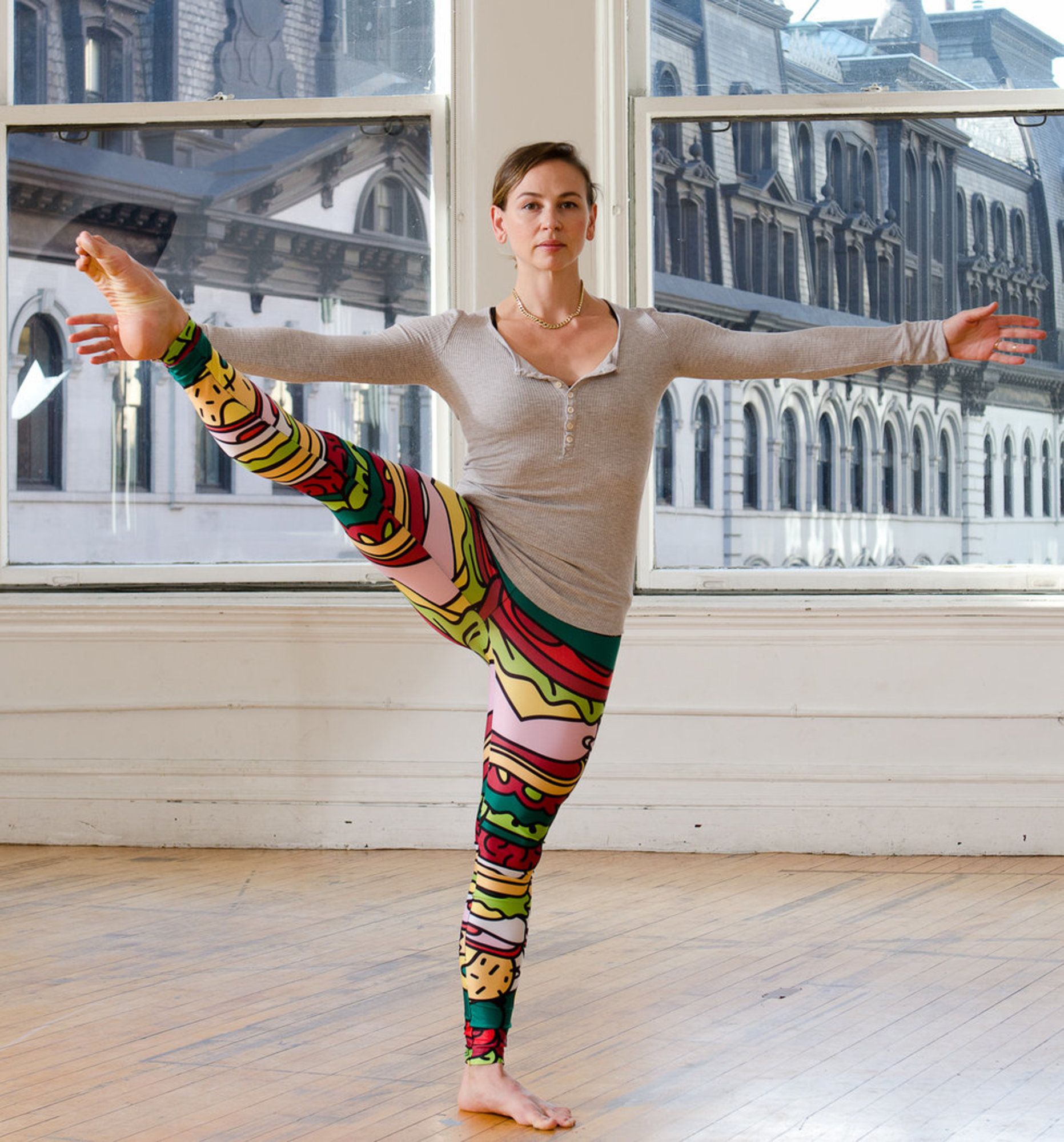
À la seconde
To the side or in the second position. À la seconde usually means a movement done by the feet to the side such as a ‘tendu’, ‘glisse’ or ‘grand battement. A technically challenging type of turn is a pirouette à la seconde, where the dancer spins with the working leg in second position in à la hauteur. This turn is usually performed by male dancers because of the advanced skills required to perform it correctly. It is seen as the male counterpart of fouettés en tournant.
Adagio
Adagio (Italian), adage (French), meaning “at ease”. In song, Adagio means “slowly”, and in ballet it means slow, enfolding movements, performed with the greatest amount of fluidity and grace as possible. In a classical ballet class, the Adagio portion of the lesson concentrates on slow movements to improve the dancer’s ability to control the leg and increase extension (i.e., to bring the leg into high positions with control and ease). Adagio combinations typically occur in the centre following exercises at the barre, and consist of the principal steps, plié, développé, attitude, arabesque, and grande rond de jambe, to name a few. In a Grand Pas (or Classical Pas de deux, Grand Pas d’action, etc.), the Adagio is usually referred to as the Grand adage, and often follows the Entrée. This Adage is typically the outward movement of the Grand Pas where the female dancer is partnered by the lead male dancer and/or one or more suitors. In ballet, the word adagio does not refer to the music accompanying the dance but rather the type of balletic movement being performed. For example, the Grand adage of the famous Black Swan Pas de deux from Swan Lake is musically an Andante, while the choreography is Adagio.
Allegro
(Italian pronunciation: [alˈlegro]) Meaning brisk, lively. A term applied to all bright, fast, or brisk movements. All steps of elevation in ballet fall under the term ‘allegro’ such as sautes, soubresauts, changement, echappe, assmeble, jete, assemble, sissone, entrechat, and so on. The majority of dances, both solo and group, are built on allegro. The most important qualities to aim at in allégro are lightness, smoothness and ballon.
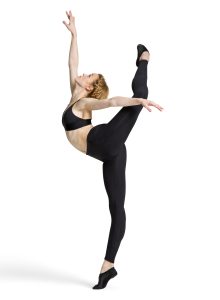
Allongé
Means to “ellongate” Adjective describing a position as stretched out or made longer, often used with arabesque.
Arabesque
Arabesque is the position of the body supported on one leg, with the other leg extended behind the body with the knee straight. The standing leg may be either bent, in plie, or straight. Arabesque is used in both allegro and adagio choreography. The working leg is placed in 4th open, a terre (on the ground) or en l’air(raised). Armline defines whether this is 1st, 2nd, 3rd or 4th Arabesque.
Assemblé
French pronunciation: [asɑ̃ble] Sometimes also pas assemblé. Literally “assembled”. A jump from two feet to two feet, where the working leg performs a battement glissé/degagé, “swishing” out. With the dancer launching into a jump, the second foot then swishes up under the first foot.
Attitude
A position in which the dancer stands on one leg (known as the supporting leg) while the other leg (working leg) is lifted and well turned out with the knee bent at approximately 90-degree angle. The lifted or working leg can be behind (derrière), in front (devant), or on the side (à la seconde) of the body. In some styles of ballet, such as RAD, the foot should be below the knee, creating an obtuse angle at the knee. In others, such as the Balanchine and Russian styles, the foot must be in line with the knee or above it, creating an angle that is 90-degrees or less. The attitude position can be performed with the supporting leg and foot either en pointe, demi pointe or on a flat foot. See also: Arabesque.
Ballerina
Italian for “female dancer”. As late as the 1950s a ballerina was the principal female dancer of a ballet company who was also very accomplished in the international world of ballet, especially beyond her own company; female dancers who danced ballet were then called danseuses or simply ballet dancers. Ballerina was a critical accolade bestowed on relatively few female dancers, somewhat similar to the title diva in opera. The male version of this term is danseur noble (French). Since the 1960s, however, the term has lost this honorific aspect and is applied generally to women who are ballet dancers. [1] In the original Italian, the terms ballerino (a male dancer, usually in ballet) and ballerina do NOT imply the accomplished and critically acclaimed dancers once meant by the terms ballerina and danseur noble when used in English. Rather, they simply mean one who dances ballet. Italian terms that do convey an accomplished female ballet dancer are prima ballerina and prima ballerina assoluta (the French word étoile is used in this sense at the Scala ballet company in Milan but has a different meaning at the Paris Opera Ballet.) Danzatore (male) and danzatrice (female) are general terms in Italian to signifiy dancers. Often “ballerino” is used in English-based countries (as slang).
Ballet technique
The foundational principles of body movement and form used in ballet.
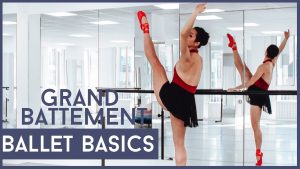
Battement
Meaning “beat”. A beating movement of the working leg (i.e. the leg that is active). Battements are usually executed in front (en avant or à la quatrieme devant), to the side (à la seconde) or back (en arrière or à la quatrieme derrière).
Chaînés
This is a common abbreviation for tours chaînés déboulés, which is a series of quick 360 degree complete rotation turns on alternating feet with progression, or chain, along a straight line or circle. The majority of the revolution is completed on the leading foot with the remainder on the trailing foot when it closes in first position. The turns are done with the feet in a small, tight first position releve. “Spotting” of the head is used to stabilize the torso in this and all turning exercises in ballet. They are also known as “chaînés tournes”. In classical ballet each rotation is done on pointes or demi-pointes (balls of the feet).
Changement
Literally “changing”. A jump in which the feet change positions in the air. For example, beginning in fifth position with the right foot front, plié and jump, switching the right to the back, landing with the left foot front in fifth position. In the Vaganova vocabulary, petit changement de pieds indicates a changement where the feet barely leave the floor.
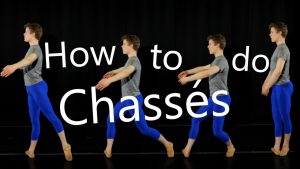
Chassé
Chassé, literally “to chase”. A slide forwards, backwards, or sideways with both legs bent, then springing into the air with legs meeting and straightened. It can be done either in a gallop (like children pretending to ride a horse) or by pushing the first foot along the floor in a plié to make the springing jump up. This step is generally found in a series, either with several of the same or a combination of movements.Like a glide.
Cloche, en
Meaning “as a bell”. Refers to grand battements executed continuously devant and derrière through the first position. See, also, Balançoire. Note: the Vaganova system currently refers to this movement as “Passe’ la Jambe” and “Battement Passe’ la Jambe”.[3]
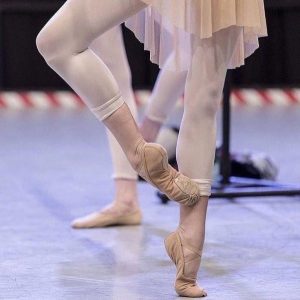
Coupé
Meaning ‘to cut’. Coupé is both a step and action: Coupé means to close, cut or tombe’ (fall) exchanging the from one leg to another and its by the ballet shoe, exchanging weight from one leg to another through a closed position, usually fifth, (rarely first or third). It is commonly executed from a sur le cou de pied front to sur le cou de pied back or vice versa. (Cou de pied positions vary greatly from method to method, school to school.) But it also may be done from an extended leg position into fondu or directly through fifth position. It can only be performed through a closed leg position. (Note: If the dancer closes, cuts or tombe’e (fall) exchanging the from one leg to another through an open position such as second or fourth it is referenced as “tombe’ or tombée.
Croisé, croisée
Meaning: crossed. One of the directions of épaulement. The dancer stands facing one of the corners of the stage; his/her body is placed at an oblique angle to the audience. The leg may be crossed to the front or to the back. Croisé is used in the third, fourth and fifth positions of the legs. The dancer is in croisé if the front leg is the right leg, and the dancer is facing the front-left corner of the stage (or dance studio); or if the front leg is the left, and the dancer is facing his/her front-right corner, then the dancer is in croisé. In croisé position the dancer should be aligned so that the audience can see both his/her shoulders and hips.
Danseur
The official term for a male ballet dancer. A male dancer can also be known as a Ballerino in Italian.

Degagé
To disengage. In-between a tendue and a grande battement, the foot slightly leaves the floor.
Demi
Meaning “half.” Applied to plié and pointe and other movements or positions to indicate a smaller or lesser version.
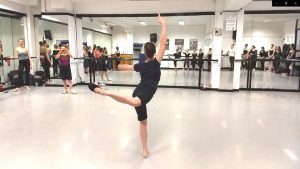
Derrière
At or to the back side. For example, a battement tendue derrière is a battement tendu taken to the rear. point/face behind you.
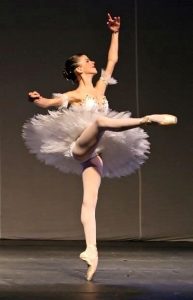
Devant
Literally “front”. For example, tendue devant would mean stretching the foot to the front, or attitude devant would mean executing an attitude to the front. point/face to front
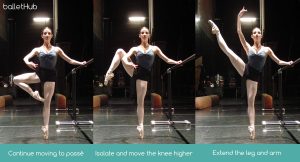
Développé
A common abbreviation for battement développé. A movement in which the leg is first lifted to retiré position, then fully extended passing through attitude position. It can be done in front (en avant), to the side (à la seconde), or to the back (derrière).
Échappé
Literally “escaped”. A movement done from a closed (first or fifth) position to an open (second or fourth) position. There are two kinds of échappés: échappé sauté and échappé sur les pointes or demi-pointes. In an échappé sauté, the dancer takes a deep plié followed by a jump in which the legs “escape” into either second (usually when starting from first position) or fourth position (usually when starting from fifth position), landing in demi-plié. In échappé sur le pointes/demi-pointes the dancer, after taking a deep plié, springs onto pointes or demi-pointes, ending in either second position (when starting from first position) or fourth (when starting from fifth) with knees straight. In all cases, the dancer may or may not return to the initial position, depending on the choreography.

Elevé
Literally “eleveate” or rise. A relevé without the plié, so that the dancer simply rises directly to demi or pointe from flat feet and straight legs all the way to the balls of the feet.
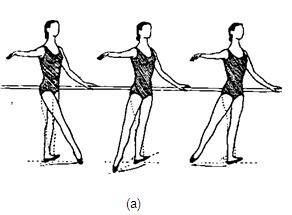
En croix
Meaning “in the shape of a cross” or “the cross.” This term is usually used when doing barre exercises such as battement tendue and battement frappé. The required movement is done to the front, then the side, then back and then again to the side (a cross shape) closing in either first or fifth position.
En dedans
Movement within a circle so that the leg starts at the back or the side and moves towards the front. For the right leg, this is a counter-clockwise circle. For the left leg, this is a clockwise circle. For instance, in a ronds de jambe en dedans, starting from first position, the foot (either left or right) would first reach tendu back, then move to tendu to the side and then front, to end again in first position. It is also considered an inside movement: in a pirouette en dedans the dancer spins the working leg moving forward or ahead of the supporting leg. The opposite is en dehors.
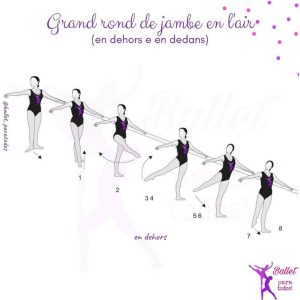
En dehors
Literally “outwards”. Movement within a circle so that the leg starts at the front or the side and moves towards the back. For the working leg, this is a clockwise circle. For instance, in a ronds de jambe en dehors, starting from first position, the foot (either left or right) would first reach tendu front, then move to tendu to the side and then back, to end again in first position. It is also considered an outside movement: in a pirouette en dehors the dancer spins towards the side of the working leg (the leg raised in passé). En dedans is the opposite. Many people have trouble and confuse en dedans and en dehors. En dehors can be remembered with the phrase “En dehors, out the door.”
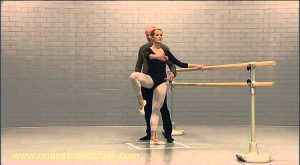
En l’air
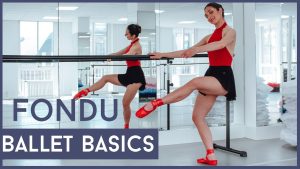
Fondu
Literally “to melt”. Abbreviation for a battement fondu, a lowering of the body that is made by bending the knee of the supporting leg. Saint-Leon wrote, “Fondu is on one leg what a plie is on two.”
Fouetté
Literally “whipped”. The term indicates either a turn with a quick change in the direction of the working leg as it passes in front of or behind the supporting leg, or a quick whipping around of the body from one direction to another. There are many kinds of fouetté: petit fouetté (à terre, en demi-pointe or sauté) and grand fouetté (sauté, relevé or en tournant). Similar to a frappe. An introductory form for beginner dancers, executed at the barre is as follows: facing the barre, the dancer executes a grand battement to the side, then turns the body so that the lifted leg ends up in arabesque.
Fouetté jeté
Literally “whipped throw”. A leap which starts as a fouetté and then the second leg also kicks in front.
Frappé
Frappé means to “strike”. See Battement frappé is hitting the floor or an ankle with a moving foot.
Glissade
Literally, to glide. This is a traveling step starting in fifth position with demi-plié: the front foot moves out to a point, both legs briefly straighten as weight is shifted onto the pointed foot, and the other foot moves in to meet the first. A glissade can be en avant, en arrière, dessous, and dessus; start in fifth position plie, push off back foot moving the front foot forward and bringing the back foot that you pushed off on in the front landing in fifth position.
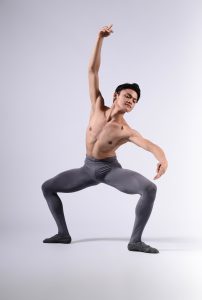
Grand plié
A full plié, or bending of the knees. The back should be straight and aligned with the heels, and the legs are turned out with knees over the feet. As a movement, it should be fluid. It may also be in preparation for another movement such as a leap. Often done in first, second, third, fourth, or fifth position.
Grand jeté
A long horizontal jump, starting from one leg and landing on the other. Known as a split in the air. It is most often done forward and usually involves doing full leg splits in mid-air. It consists basically of a grand écart with a moving jump. The front leg brushes straight into the air, as opposed to performing dévelopé or “unfolding” motion. The back leg follows making the splits in the air. It can be performed en avant (forward), à la seconde (to the side), en arrière (backward), and en tournant (turning en dedans).The dancer must remember to hit the fullest split at the height of the jump, with weight pushed slightly forward, giving the dancer a gliding appearance. Very likely or commonly used in modern ballet, as well.
Grand Pas and Grand Pas d’action
Literally, big or large step. A Grand pas is a suite of individual dances that serves as a showpiece for lead dancers, demi-soloists, and possibly the corps de ballet. In the context of a full-length ballet the Grand pas is considered a Pièce de résistance. The Grand pas is merely a display of dance, and in no way contributes to the ballet’s story.
Jeté
Jeté is a jump from one foot to the other similar to a leap, in which one leg appears to be “thrown” in the direction of the movement (en avant, en arrière or sideways). There are several kinds of jetés, such as petit jeté, grand jeté, en tournant, jeté entrelacé, etc.
Partnering
In general, partnering is an effort by both the male and female dancers to achieve a harmony of movement so that the audience is unaware of the mechanics to enjoy the emotional effects. Also known as pas de deux, or dance for two. For a male dancer, partnering includes lifting, catching, and carrying a partner, also assisting with jumps, promenades and supported pirouettes.
Pas
Literally, “step”. In ballet, the term pas often refers to a combination of steps which make up a dance (typically, in dance forms such as jazz, hip-hop, tap, etc., this is called a routine). Pas is often used as a generic term when referring to a particular suite of dances, i.e. Pas de deux, Grand Pas d’action, etc., and may also refer to a variation. The use of the word pas when referring to a combination of steps which make up a dance, is used mostly in Russia, and much of Europe, while in English speaking countries the word combination is often used.
Pas de basque
“step of the Basques”. Halfway between a step and a leap, taken on the floor (glissé) or with a jump (sauté); it can be done moving toward the front or toward the back. This step can also be found in Scottish highland dance. The dancer starts in fifth position croisé and executes a plié while brushing the front leg out to tendue front. The front leg does a demi rond de jambe to the opposite corner in the back while the dancer turns to face the other front corner. The weight is quickly transferred onto the working leg (the one that was front). The dancer brushes the supporting leg through first position and then executes a chassé forward onto the supporting leg and closes in croisé.
Pas de bourrée
It consists of three quick steps i.e. behind, side, front, often ending in a demi plié, especially if followed by another pas de bourrée. It means ‘Step of Bourrée’, Bourrée being an Auvergne dance.
Pas de chat
“the step of the cat”. The dancer jumps sideways, and while in mid-air, bends both legs up (two retirés) bringing the feet up as high as possible, with knees apart.
Pas de cheval
“step of the horse”. The dancer does a cou de pied then a small developpé and tendu back into starting position.
Pas de deux
meaning “step of two”. Pas de deux is a duet usually performed by a female and a male dancer. A famous pas de deux is the Black Swan pas de deux.
Pas de poisson
“step of the fish”. Same as temps de poisson. This is a type of soubresaut, or a jump without change of feet. From fifth position, the dancer executes a deep demi plié and jumps arching the back with the legs straightened behind, so that the whole body is curved like a fish jumping out of water.
Pas de valse
“waltz step”. A traveling step done to music in 3/4 time, either straight or while turning (en tournant).
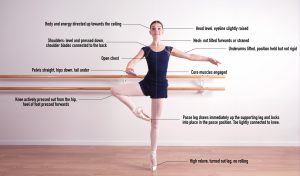
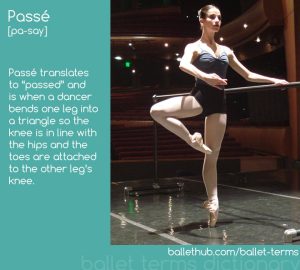
Passé
Meaning ‘to pass’. As a position passé means when a foot is placed near, on, below, or above the other knee. As a movement passé refers to the working foot passing close to the knee of the standing leg. When the foot arrives by the knee, it passes from the front to the back or back to front, and continues either to return to the floor by sliding down the supporting leg or into an arabesque or attitude etc. See Retiré.
Petit saute
A small jump, in which the feet do not change positions in mid-air; also called temps levé sauté in the Vaganova vocabulary.
Piqué
Literally “pricked”. A movement in which the strongly pointed toe of the lifted and extended leg sharply lowers to hit the floor then immediately rebounds upward.
Pirouette
Means to “whirl”. A controlled turn on one leg, starting with one or both legs in plié and rising onto Relevé (usually for men) or pointe (usually for women). The non-supporting leg is be held in Passé. The pirouette may return to the starting position or finish in arabesque or attitude positions, or proceed otherwise. A pirouette is most often en dehors turning outwards toward the back leg, but can also be en dedans turning inwards toward the front leg. Although ballet pirouettes are performed with the hips and legs rotated outward (“turned out”), it is common to see them performed with an inward rotation (“parallel”) in other genres of dance, such as jazz and modern. Turning technique includes spotting, in which a dancer executes a periodic, rapid rotation of the head that serves to fix the dancer’s gaze on a single spot. Spotting is particularly important in traveling turns such as tours chaînés or piqués because it helps the dancer control the direction of travel while keeping balanced. Pirouettes can be executed with a single or multiple rotations.
Plié
Means – A smooth and continuous bending of the knees. This can be grand-plié, a bend to the deepest position. For demi-plié the dancer bends knees until just below the classical hips while maintaining turn-out at the joints, allowing the thighs and knees to be directly above the line of the toes. The intention here is keep the heels on the ground as long as possible. In either instance, the motion is fluid and does not stop in downward bend. As soon as the bottom of the bend is reached the bend is reversed and the straightening of the legs is begun, equally as smoothly.
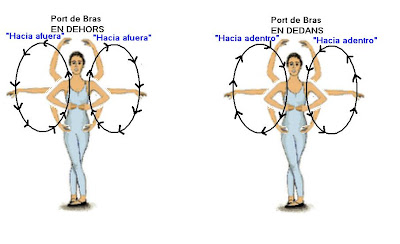
Port de bras
Literally “carriage of the arms”. Sometimes misspelled “porte-bras”. An exercise for the movement of the arms to different positions, it is considered a simple movement but a dancer works hard to make it seem graceful, poised and seamless. The basic port de bras exercise moves from fifth en bas to first arm position, to second arm position, then back down to fifth en bas. A full port de bras moves from fifth en bas to fifth overhead and back down but a variation of sequence is common.
Relevé
Literally “Rise up” or “lifted”. Rising from any position to balance on one or both feet on at least demi-pointe which is heels off the floor or higher to full pointe (commonly for girls) where the dancer is actually balancing on the top of the toes, supported in pointe shoes. Smoothly done in some versions, a quick little leap up in other schools.
Retiré devant
The working leg is raised just in front of the knee cap (but can be raised higher) and is sharply bent and “turned out” to the side. It is a common pose during standard pirouette both en dedans and en dehors, and an intermediate position for other moves, such as battement développé front.
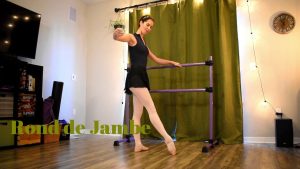
Rond de jambe
Means “round of the leg”/“circle of the leg”Actually, half-circles made by the pointed foot, returning through first position to repeat; creating the letter ‘D’ on the floor. From front to back rond de jambe en dehors, or from back to front rond de jambe en dedans.
Rond de jambe à terre:
straightened leg with pointed toe remaining on the ground to sweep around.
Rond de jambe en l’air:
in the air. The leg is lifted to the side, movement is only below the knee. If the thigh is horizontal, the toe draws an oval approximately between the knee of the support leg and the second position in the air. If the thigh is in the lower demi-position then the oval is to the calf of the support knee.
Grande rond de jambe:
the leg is straightened and sustained at grand battement height, with the foot making the circle high. Requires advanced “extension” flexibility and strength. If not reversed, foot returns past the knee.
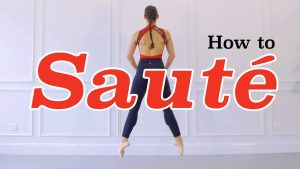
Sauté
Literally “jump”. As adjectives, sauté (masc.) or sautée (fem.) French pronunciation: [sote] are used to modify the quality of a step: for instance, “‘sauté arabesque indicates an arabesque performed while jumping.
Saut de chat
A jump similar to a “grande jété” where the front leg extends with a développé.
Second position, seconde
Second position of the leg – The dancer stands with feet turned out along a straight line as in first position, but with the heels about one foot apart. The term seconded generally means to or at the side, Second position of the arm – raises your arms to the side. Keep your arms slightly rounded. Lower your elbows slightly below your shoulders. Make sure your wrists are lower than your elbows. Keep your shoulders down, your neck long and your chin up.
Sickle
A term that refers to the reverse of a winging of the foot. If a dancer sickles the foot on pointe or demi-pointe, the ankle could collapse to the outside resulting in a sprained ankle. If it is the working foot sickled, it will make the dancer look amateurish and untrained. Working foot to the side should be straight and mildly winged when foot is to the front or back.
Sissonne
A jump done from two feet to one foot. Named after the originator of the step. In a sissonne over the back foot closes in front and in a sissonne under the front foot closes behind. Exceptions to the traditional sissonne include sissonne fermee, sissonne tombe, and sissonne fondue, which all finish on two feet.
Soubresaut
A sudden spring or jump from both feet, traveling forward in either first third or fifth position and landing on both feet in the same position as they started.

Sous sous
Literally under. Also, perhaps more commonly, sous sus [under over]. Typically executed from fifth position, a dancer rises up onto the pointes or demi-pointes with the feet touching and ankles crossed in a particularly tight fifth position relevé, so that the two legs look like one, and resemble a sword or an exclamation point. It is a striking pose achieved without much difficulty, since both feet are directly beneath the spine, and is much used in choreography. The action can be performed in place or traveling forward, backward or to the side. At the barre after the plié exercises, is part of the warm up for center pointe work. Sous sous is a term of the Cecchetti school.
Soutenu en tournant
Similar to tours chaînés, a soutenu is a series of turns in quick succession. The dancer must first execute a demi plié while extending the leading leg in a tendu position and then stepping up on a tight leg and beginning the turn while simultaneously bringing the other leg up to a raised position while finishing a full 360 degree turn.
Split
A split is a configuration of the legs to a straight 180 degree (or more, oversplit), they can be done in right, left, or center positions, the ability to do a split also demonstrates the flexibility of the dancer. Splits are usually done as floor work, barre work or incorporated into dances; the ability to do splits is critical to ballet dancers as it allows for proper execution of certain movements, for example, the Grand Jeté, Arabesque Penchée and many other movements. Proper execution of a ballet split includes turned out legs from the hip and pointed feet, without proper technique it may be harmful or impossible for the dancer to perform a proper split. A notable difference between front splits in ballet and gymnastics is the turnout of the back leg, in gymnastics the back leg faces downwards, in ballet the back leg faces to the side.
Sur le cou-de-pied
French pronunciation: [syʀləkudɘpje] Literally, “on the neck of the foot”. The working foot is placed on the part of the leg between the base of the calf and the beginning of the ankle. On the accent devant (front), the heel of the working is placed in front of the leg, while the toes point to the back, allowing the instep (cou-de-pied in French) of the working foot to “hug” the lower leg, thus giving the position its name. On the accent derrière (back), the heel of the working leg is placed behind the leg with the toes point to the back. The action of alternating between devant and derrière is seen in the petit battement.
Sway back
Arching the back too far, resulting in an appearance of bad posture.
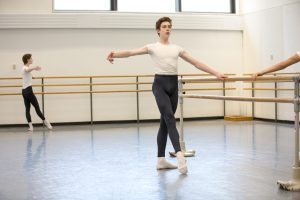
Tendue
Literally, “to stretch the ankle and foot”/”stretched” ; a common abbreviation for battement tendue. Usually done as an exercise at the barre from first or fifth position, the working leg is extended to either the front, side or back, gradually along the floor until only the tip of the toe remains touching the floor (tendu a terre) or even further stretched so that the tip of the toe comes up off the floor a few inches (en l’air). A tendu can also be used in preparation for other more complex steps, such as pirouettes, or leaps
Tours en l’air
Literally “turn in the air”. A jump, typically for a male, with a full rotation. The landing can be to both feet; on one leg with the other extended in attitude or arabesque; or down to one knee, as at the end of a variation. A single tour is a 360° rotation, a double is 720°. Vaslav Nijinsky was known to perform triple tours en l’air.
Tombé
The act of falling. Typically a beginning movement. In the Vaganova school, its complete name is sissone ouverte tombé. For a tombé en avant, the dancer begins with a coupé front and then, after extending the leg from the coupé in fourth position front (or second or fifth back, if the tombé is to be done on the side or backward), switches the weight distribution and leans on the extended leg, which is placed on the floor in a deep plié. This leaves the working leg straightened but lifted slightly off the floor. Often this movement is used before executing traveling steps such as a pas de bourrée. It is also possible not to perform the coupé at the beginning of the movement, but rather reach the fourth position front directly from fifth position with a little ‘sliding’ hop.
Triple Runs
One big step, followed by two little steps, can be done in a circle.
Turn-out, turnout
A rotation of the leg from the hips, causing the knee and foot to also turn outward, away from the center of the body. This rotation allows for greater extension of the leg, especially when raising it to the side and rear. Properly done, the ankles remain erect and the foot arch remains curved and supporting. Signs of improper turn-out are the knee pointing forward while the foot point sidewards (turning out from the knee), and rolling in of the ankle. Every single step in classical ballet is performed with hips, knees and feet as turned out as possible, except when otherwise specified by choreography. Turn-out is a defining characteristic of classical ballet which distinguishes it from other forms of dance. A perfect turn-out would be the ability to effortlessly rotate the legs from the hips so that the feet and knees pointed, not straight ahead of the body, but directly to the outsides of the body. Not all dancers have a perfect turn-out; but it is definitely a measure for selection in the competitive world of ballet. In beginner classes, a less-than-perfect turn-out is tolerated to save stress to knee joints until the ability is acquired. But as students progress to pre-professional and professional levels, perfect or near perfect turn-out is almost always a requirement for employment and success.
Waltz
Either a type of ballet music, counted in 3/4 music tempo (as “one, two, three”) or a step in ballet dance, which can be done in a variety of ways. The waltz step actually involves three steps performed on each count of the “(and) one, two, three”. The waltz step can be repeated in a chain as long as desired. The position of the arms variation
